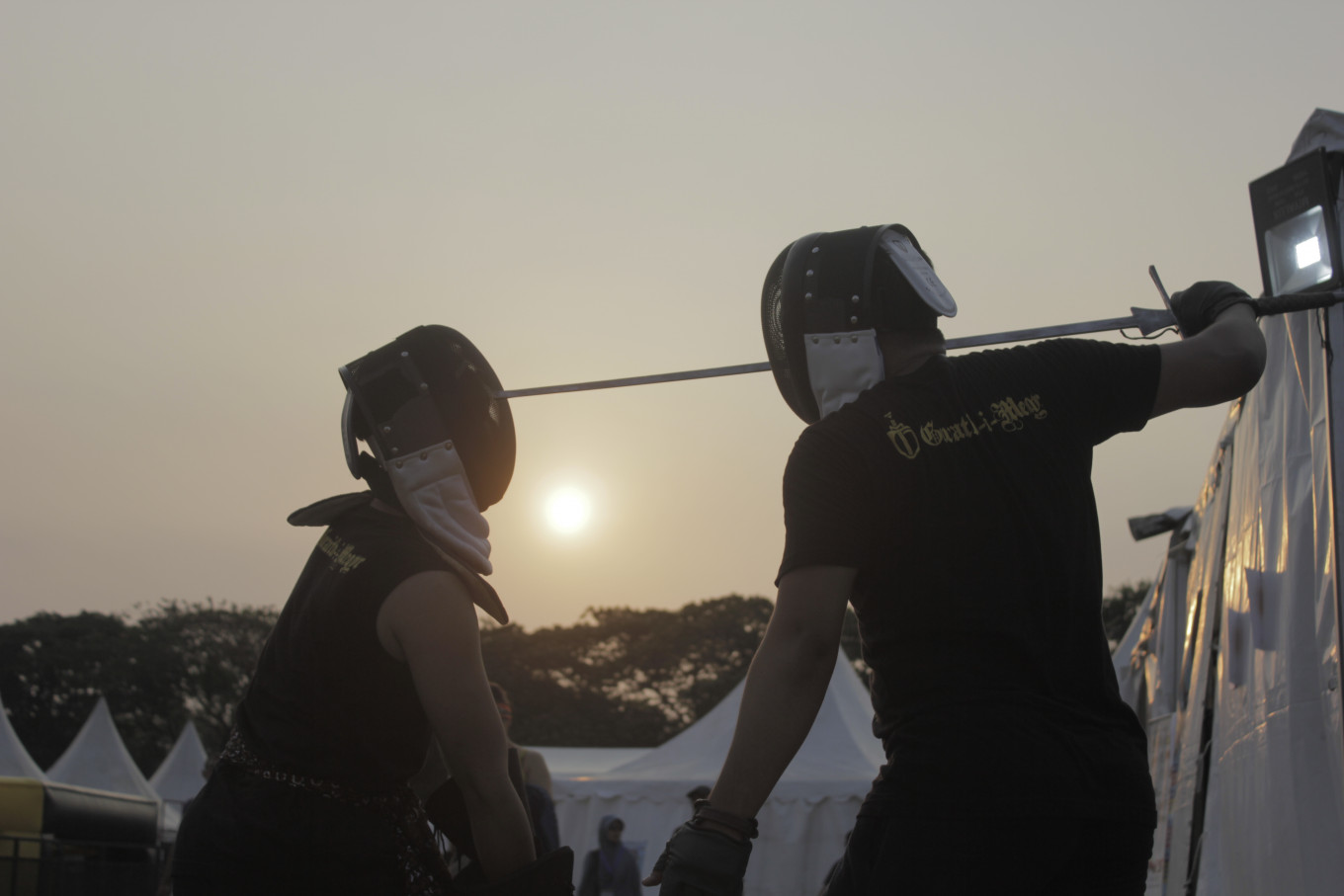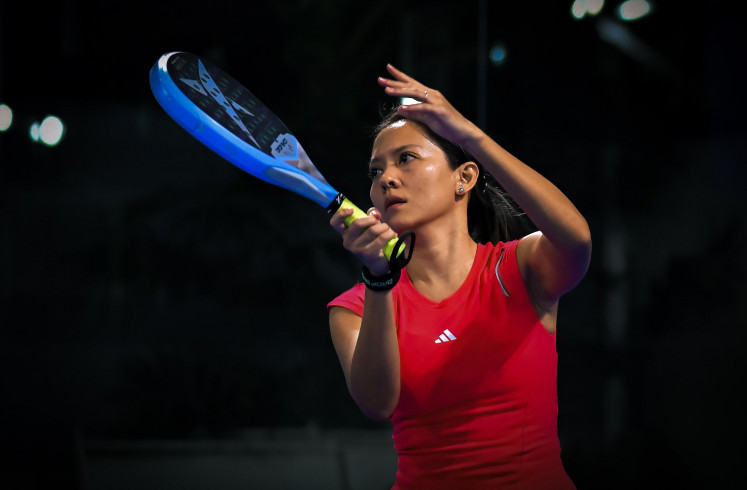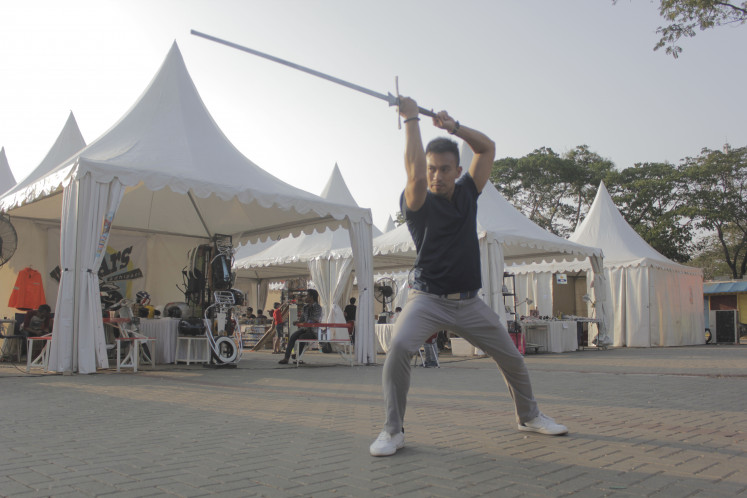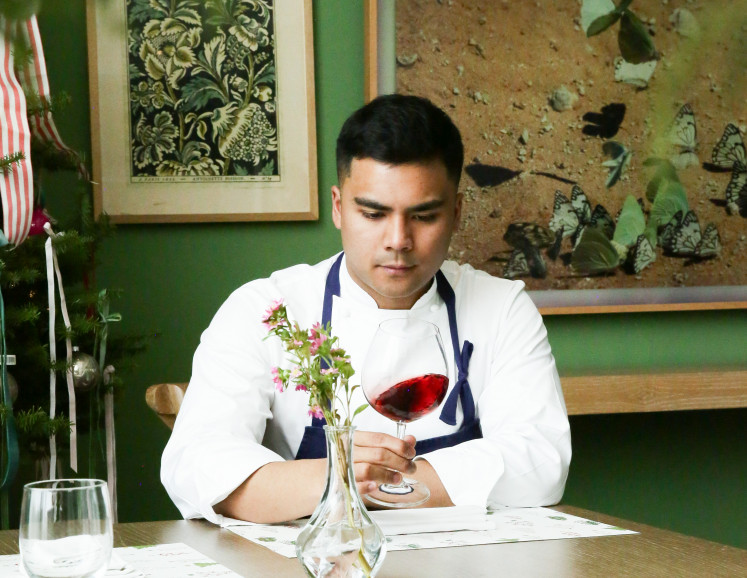Popular Reads
Top Results
Can't find what you're looking for?
View all search resultsPopular Reads
Top Results
Can't find what you're looking for?
View all search resultsModern knights: Indonesians study historical European martial arts with Gwaith-i-Megyr
"Martial arts" often invokes mental images of a Shaolin monk swinging his staff, a karateka performing the kata or a Muay Thai fighter stomping the ground. For some, however, martial arts also come in the form of medieval European disciplines.
Change text size
Gift Premium Articles
to Anyone
"Martial arts" often invokes the mental images of a Shaolin monk swinging his staff, a karateka performing the kata or a Muay Thai fighter stomping the ground. For some, however, martial arts also come in the form of medieval European disciplines.
Despite not being as famous as their Eastern counterparts, historical European martial arts (HEMA) have been gaining more attention in recent years, including in Indonesia.
Compared to Eastern-style martial arts, HEMA has not been a living practice until recently, as due to the development of firearms in Europe that changed how wars were fought, medieval martial arts died and came to be forgotten. Fast forward to the late 19th and early 20th centuries, people began the efforts to revive the arts.
"If it's a living practice, then we would call it [simply] European martial arts, not historical European martial arts," said Dwiki Mahendra Putra, 30, a manager at a creative studio in Jakarta.
Dwiki explained that unlike in Eastern martial arts, there is no belt system in HEMA, and as it is a collection of dead martial arts, no one can really be called a true master in the same sense as in Eastern martial arts. "We have, however, mentors, like mas Ari, but they are no 'masters' of the art."
Inspired by Tolkien's works
Ari, who shared only his nickname, is one of the frontrunners of HEMA in Indonesia. Now a mentor at Gwaith-i-Megyr, he taught himself historical European swordsmanship beginning in 2007 along with two of his seniors.
"There were no clubs at that time," he said.
Gwaith-i-Megyr, as Ari described, is not a martial arts school but rather a martial arts study group. Gwaith-i-Megyr itself means "Fellowship of Swordsmen" in Sindarin, a fictional language created by acclaimed writer JRR Tolkien.
"I have always been a fan of The Lord of the Rings, and I really admire how it portrays swordsmanship [in the novels and the movies]. So much so that I said to myself, 'I want to learn how to fight with a sword'," said Riri Rafiani, a 48-year-old lecturer at Atma Jaya University.
Riri then met Ari and Dani, with whom she established the study group.
"Then, someone introduced me to Ari. So, I asked him to teach me HEMA, to which he said 'yes'. Thus, we established Gwaith-i-Megyr along with another cofounder, Dani," said Riri, a Jakarta native of Sundanese and Javanese descent.
"Dani brought in 10 of his wooden swords from Bandung [West Java] to Jakarta. We bought them all and started training — exactly on Feb. 7, 2016.”
Dwiki, on the other hand, was already a swordsman prior to joining Gwaith-i-Megyr. The art he practiced, however, was an entirely different discipline. He began practicing HEMA after meeting Ari.
"I met mas Ari in a Star Wars community that focused on lightsaber choreography. Not long after Gwaith-i-Megyr was founded, he invited me to join. I wanted to learn the science of sword fighting to apply it to my lightsaber choreography, but then I came to commit myself to learn HEMA instead," Dwiki said.
The master: Members of Gwaith-i-Megyr are allowed to study other weapons after they master the basics of longsword fighting as instructed by grandmaster Fiore Furlano de'i Liberi. (Courtesy of Gwaith-i-Megyr) (Personal collection/Courtesy of Gwaith-i-Megyr)Interpreting ancient manuscripts
Gwaith-i-Megyr is a research-based group, meaning that members are allowed, even encouraged, to study medieval martial arts manuscripts to accompany their training.
"HEMA draws its sources from ancient manuscripts, from the 1600s, 1700s and so on. As it has been said, HEMA is a collection of dead martial arts. Unlike pencak silat or kendo, where you can trace each generation of practitioners back to the original masters, in HEMA, that is not the case," Riri explained.
Therefore, the challenges faced by HEMA practitioners include interpreting medieval texts, Riri further explained.
"As our sources are ancient texts, we need to deal with languages from the medieval world, including 1600s or 1700s English, which is an entirely different language from today's English. At Gwaith-i-Megyr, we read the modern English translations, but still, trying to interpret them confuses us more often than not," Riri continued.
"What we practice here at Gwaith-i-Megyr is mainly the art of sword fighting as practiced by grandmaster Fiore [Furlano de'i Liberi] from Italy. There are also many other ancient texts that HEMA practitioners study, including from England, Germany, Spain, France and more.”
Medieval weapons existed in all forms, ranging from spears and longbows to polearms. Despite swords being the most popular choice for HEMA practitioners today, it does not mean other weapons were not equally important.
"The world of HEMA really is vast. At Gwaith-i-Megyr, members are recommended to study the basics of Fiore's longsword techniques, but they are welcome to explore," said Dermawan Saputra, a veterinarian at a clinic in Jakarta who joined the club to fill his free time.
"If after you master the basics, you want to study medieval manuscripts on the spear or the longbow, you can totally do that. Gwaith-i-Megyr should not be mistaken as just a place where you learn swordsmanship. It is actually more of a place where you study ancient martial arts manuscripts and practice them."
That being said, practicing HEMA requires one to be physically fit.
"We use all of our body, from head to toe," Putra, whose weapon of choice is the saber, said.
"Some of the weapons we use are quite heavy, I should say. If we focus on strengthening only our hands and arms, we won't [be able to] perform the techniques well. Definitely, you must have a good core."
"One can be misled into thinking that swordsmanship only requires the arm muscles. [However], the core muscles are especially important for stability, and the lower body is important for balance," Dwiki added. "Most importantly, you have to have good stamina. The sparring sessions honestly feel like running a marathon."
Nevertheless, a Gwaith-i-Megyr training session does not include a workout session. While members are required to be physically fit, they are expected to take care of their physique at home.
"At Gwaith-i-Megyr, what is practiced by members should come from medieval martial arts manuals. There is no curriculum in the strictest sense. The curriculum is whatever the mentors excel at. I myself specialize in a technique that was practiced in medieval Italy, while Dani draws his sources from German manuals," Ari explained.
"In short, practicing HEMA with Gwaith-i-Megyr requires members to do a lot of reading and studying manuscripts. We used to include a workout session in our weekly training, but it was not sustainable due to our time being limited. So, members really need to maintain their fitness at home.
"Now, a Gwaith-i-Megyr training session comprises discussing texts, practicing the techniques and sparring.”
Riri asserted that the studying aspect of HEMA was what made it stand out from other martial arts.
"If you think about it, HEMA is a very interesting discipline as it partly relies on our ability to study the manuals. This martial art can be a medium for us to sharpen our skills in comprehending and interpreting old text," said Riri.
"In other martial arts, you come to the dojo, and they'll teach you how to fight step by step, but in HEMA, you are encouraged to dive into the sources. This martial art requires a scholarly effort."













